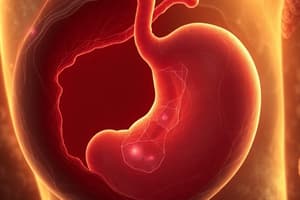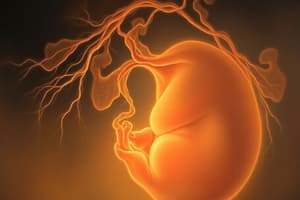Podcast
Questions and Answers
Which layer of the gastrula becomes skin and nervous tissue?
Which layer of the gastrula becomes skin and nervous tissue?
- Ectoderm (correct)
- Mesoderm
- Endoderm
- Gastrula layer
The mesoderm develops into the digestive organs.
The mesoderm develops into the digestive organs.
False (B)
What does the endoderm develop into?
What does the endoderm develop into?
Digestive organs and lining of the digestive tract
The ________ layer of cells in the gastrula forms muscle tissue.
The ________ layer of cells in the gastrula forms muscle tissue.
Match the following layers of the gastrula with their respective developments:
Match the following layers of the gastrula with their respective developments:
What structure indicates the opening of the gastrula?
What structure indicates the opening of the gastrula?
Hox genes are responsible for determining the roles of different cell types in tissue development.
Hox genes are responsible for determining the roles of different cell types in tissue development.
What do Hox genes affect during animal development?
What do Hox genes affect during animal development?
What type of feeder are sponges classified as?
What type of feeder are sponges classified as?
Sponges have complex tissues and organs.
Sponges have complex tissues and organs.
Name one characteristic that defines cnidarians.
Name one characteristic that defines cnidarians.
Sponges and cnidarians are among the first animals to evolve from a _______ ancestor.
Sponges and cnidarians are among the first animals to evolve from a _______ ancestor.
Match the following terms with their definitions:
Match the following terms with their definitions:
Which of the following statements is true about sponges?
Which of the following statements is true about sponges?
Sponges can easily be broken apart and reformed.
Sponges can easily be broken apart and reformed.
What does it mean for an organism to be sessile?
What does it mean for an organism to be sessile?
What type of symmetry is characteristic of cnidarians?
What type of symmetry is characteristic of cnidarians?
Cnidarians have body structures similar to those of sponges.
Cnidarians have body structures similar to those of sponges.
What are the two layers of cells in cnidarians responsible for?
What are the two layers of cells in cnidarians responsible for?
Cnidarians contain about ______ species, most of which are marine.
Cnidarians contain about ______ species, most of which are marine.
Match the following cnidarians with their characteristics:
Match the following cnidarians with their characteristics:
What function does the outer layer of cnidarians serve?
What function does the outer layer of cnidarians serve?
Cnidarians have three body openings.
Cnidarians have three body openings.
Name one of the protective measures you could take while snorkeling around a coral reef.
Name one of the protective measures you could take while snorkeling around a coral reef.
What type of cells are involved in digestion, production of eggs and sperm, and excretion in sponges?
What type of cells are involved in digestion, production of eggs and sperm, and excretion in sponges?
All sponges have spicules made of calcium carbonate.
All sponges have spicules made of calcium carbonate.
What are the support structures of sponges called?
What are the support structures of sponges called?
Most sponges belong to the class __________.
Most sponges belong to the class __________.
Which class of sponges is known for having a netlike skeleton that resembles spun glass?
Which class of sponges is known for having a netlike skeleton that resembles spun glass?
Calcareous sponges have spicules made of silica.
Calcareous sponges have spicules made of silica.
The cells in sponges that can become specialized to secrete spicules are known as __________.
The cells in sponges that can become specialized to secrete spicules are known as __________.
Match the following classes of sponges with their characteristics:
Match the following classes of sponges with their characteristics:
What do gemmules in freshwater sponges contain?
What do gemmules in freshwater sponges contain?
Most sponges reproduce sexually.
Most sponges reproduce sexually.
What happens to a zygote after fertilization in sponges?
What happens to a zygote after fertilization in sponges?
Most sponges are ______, meaning they can produce both eggs and sperm.
Most sponges are ______, meaning they can produce both eggs and sperm.
Match the sponge reproduction methods with their descriptions:
Match the sponge reproduction methods with their descriptions:
What is the result of sperm being released into the water?
What is the result of sperm being released into the water?
Sponges are never at risk of being eaten due to their toxic compounds.
Sponges are never at risk of being eaten due to their toxic compounds.
What occurs after a larva attaches to a surface?
What occurs after a larva attaches to a surface?
Flashcards are hidden until you start studying
Study Notes
Gastrulation and Tissue Development
- The inner layer of the gastrula is called the endoderm
- The endoderm cells develop into the digestive organs and the lining of the digestive tract
- The outer layer of cells in the gastrula is called the ectoderm
- The ectoderm cells in the gastrula continue to grow and become the nervous tissue and skin.
- A layer of cells called the mesoderm forms between the endoderm and the ectoderm.
- The mesoderm forms from pouches of endoderm cells on the inside of the gastrula.
- Mesoderm cells become muscle tissue, the circulatory system, the excretory system, and in some animals, the respiratory system.
Sponges
- Sponges are filter feeders and have no tissues, organs, or symmetry.
- Sponges are diverse and have three classes based on their support system:
- Demospongiae: contains spongin fibers, silica, or both.
- Calcarea: contains calcium carbonate spicules.
- Hexactinellida: contains silica spicules.
- Sponges reproduce sexually and asexually.
- Sexual reproduction: involves sperm and eggs, and the zygote develops a flagellated larva that eventually settles and develops into an adult.
- Asexual reproduction methods include budding and the formation of gemmules (seedlike particles containing sponge cells).
- Predation on sponges: Sponges are food for some tropical fishes and turtles.
Cnidarians
- Cnidarians are marine animals with one body opening and radial symmetry.
- They have two cell layers organized into tissues with specific functions.
- The outer layer protects the internal body.
- The inner layer functions in digestion.
Studying That Suits You
Use AI to generate personalized quizzes and flashcards to suit your learning preferences.




